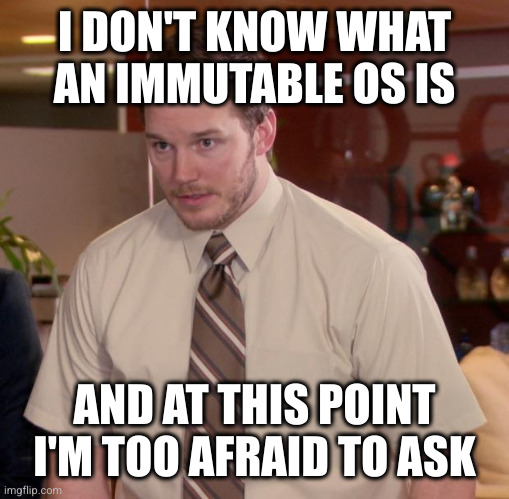this post was submitted on 24 Jul 2024
515 points (97.8% liked)
linuxmemes
21304 readers
1109 users here now
Hint: :q!
Sister communities:
- LemmyMemes: Memes
- LemmyShitpost: Anything and everything goes.
- RISA: Star Trek memes and shitposts
Community rules (click to expand)
1. Follow the site-wide rules
- Instance-wide TOS: https://legal.lemmy.world/tos/
- Lemmy code of conduct: https://join-lemmy.org/docs/code_of_conduct.html
2. Be civil
- Understand the difference between a joke and an insult.
- Do not harrass or attack members of the community for any reason.
- Leave remarks of "peasantry" to the PCMR community. If you dislike an OS/service/application, attack the thing you dislike, not the individuals who use it. Some people may not have a choice.
- Bigotry will not be tolerated.
- These rules are somewhat loosened when the subject is a public figure. Still, do not attack their person or incite harrassment.
3. Post Linux-related content
- Including Unix and BSD.
- Non-Linux content is acceptable as long as it makes a reference to Linux. For example, the poorly made mockery of
sudoin Windows. - No porn. Even if you watch it on a Linux machine.
4. No recent reposts
- Everybody uses Arch btw, can't quit Vim, and wants to interject for a moment. You can stop now.
Please report posts and comments that break these rules!
Important: never execute code or follow advice that you don't understand or can't verify, especially here. The word of the day is credibility. This is a meme community -- even the most helpful comments might just be shitposts that can damage your system. Be aware, be smart, don't fork-bomb your computer.
founded 1 year ago
MODERATORS
you are viewing a single comment's thread
view the rest of the comments
view the rest of the comments

Another prominent example is Android. Sure system apps can be upgraded individually -- by storing the new version in a restricted part of the 'user' partition -- but otherwise the system files are strictly read only until a new 'image' is 'flashed' to it by the update system or a power user with debugging tools. In the past, a common use of root capabilities was to remount the system partition as read/write and then change files on it directly. It's more complex now.
That's also why system apps can be rolled back to the stock version, and can sometimes be disabled, but can't be directly uninstalled like user apps. Only the updated version on the user partition (if there is one) can be removed.
Aren't apps better compareable to something like flatpack and this is the reason why they are updateable during runtime?
Sure they are, but system apps are still installed in the immutable space initially, which is the important thing, that updates to it can't go there.
I don't know how desktop immutable systems deal with that.
You can update the whole base image. Vanilla OS and SteamOS have an A/B partition that holds the currently-in-use image and can also hold a to-be-used image.
Updating works by adding the to-be-used image, setting a configuration option that tells the system to boot that one, and on the next boot it'll check if the new one is bootable, then either boot it and mark it as working, or boot into the old one and display an error about how out wasn't able to boot into the new one.
There's smart things going on like maybe hard linking files that didn't change between the two images and therefore saving space and copying time.
The result is that you never have a broken system, but you can still frequently update the base image.